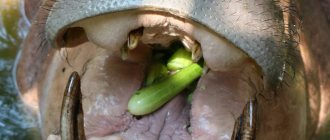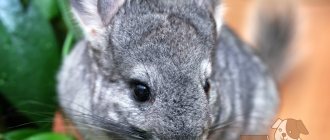Mighty giant. What is he like?
The largest land mammal on Earth is the elephant. The giant is very handsome, friendly and sociable. The population of this animal is approximately 600 thousand individuals.
The body weight of a male can reach 5 tons, its length is approximately 7.5 m, its height reaches 3.5 m. The thickness of the skin is about 2.5 cm. The elephant has an amazing organ - the trunk, it serves as its nose, hand, and also strong weapon. Thanks to it, he drinks, breathes, with its help he can take food, and makes loud trumpet sounds. Elephants have highly developed front incisors, which protrude far forward and are called tusks. The older the animal, the larger the tusks. In males they are much larger than in females, they can reach 2.5 meters!
Despite the fact that the elephant's skin is thick, it is very sensitive to the bites of various insects. Giants do not like the sun, which is why they often take mud baths.
Cow, 240 to 311 days
A cow's pregnancy lasts a little longer. This condition is called pregnancy, the duration of the period can vary from 240 to 311 days.
Two months before giving birth, veterinarians recommend switching the cow to dry milking, that is, not milking. Over the past couple of months, the fetus has been actively growing and needs more and more nutrients. At this time, milk becomes less and less.
The average weight of newborn calves is 30 kilograms. Literally immediately after birth, the calf is able to stand on its feet, although at first it also needs help.
During the first two weeks, the animal will adapt and become more independent.
Elephant life
Elephants gather in herds and live in large groups of about 10-12 individuals. They are often led by females. And they are the ones who determine where and for how long to stop for rest. Their sleep lasts no more than 4 hours.
Mighty giants deftly and effortlessly pass through dense thickets and forest wilds, while moving almost silently. Elephants confidently and easily swim across wide bodies of water.
These animals feed on various vegetation and consume about 450 kg of grass and leaves per day. For a comfortable existence, an animal needs to drink at least 150-300 liters of water per day.
Lifestyle
Elephants are considered the largest animals that can be found on land. These giants belong to the class of mammals and are very social animals. Their natural habitat is Southeast Asia and Africa.
Elephants live in families, and complete matriarchy reigns in families, and males are expelled from the herd at a young age (or they leave on their own). Adult males live solitary lives and approach the family only to mate with a mature female. An elephant family consists of the eldest elephant, her daughters (with children) and other female relatives.
By nature, elephants are nomads. It is the eldest female who leads her family in search of food, and she decides where to go, where and how long to rest.
These huge animals are very sociable and enjoy communicating with their own kind. Tactile contact plays a huge role in the life of giants. They touch each other with their trunks, stroke them as a sign of greeting, and the older ones kick the younger ones as punishment. Members of the same family treat each other with great attention; special care and attention is given to a sick or dying elephant.
How long does pregnancy last in elephants?
Now let's move on to animal reproduction. You're probably wondering how long pregnancy lasts for elephants? There is an interesting pattern in nature: this period directly depends on the weight and size of the animal. Knowing the parameters of elephants, it can be assumed that bearing offspring occurs over many months. Now a little more about how many months an elephant’s pregnancy lasts.
Scientists have studied this issue for a long time. This was done through observations of the lives of animals in the wild, in zoos and nurseries. Now biologists know not only how long pregnancy lasts in elephants, but also how mating occurs, pregnancy in elephants proceeds, about the birth itself and caring for the offspring.
Gestation of offspring occurs for approximately two years, or more precisely, for 1 year and 10 months. This means that female elephants can give birth to cubs once every 4-5 years. This is the longest pregnancy in the animal kingdom.
The fetus develops throughout pregnancy, and at 531 days the baby elephant inside the mother is fully developed, the rest of the time it only grows and gains weight.
Opossums
This is also a cat, only a marsupial. Marsupials generally have a curious history with pregnancies: they give birth not to babies, but to embryos, which can weigh less than a gram and barely reach a centimeter in length. Their pregnancy can last only eight days! The marsupial marten carries cubs for 11 days, and gives birth to up to 24 babies at a time. And even in kangaroos, the largest marsupials, a baby is born a maximum of 40 days after conception. Then the embryo crawls into the pouch, clings to the nipple and there it “ripens” to relative independence. By the way, kangaroos generally can work miracles - they can “freeze” pregnancy. If suddenly the female realizes that there is little food, water, unfavorable conditions, and the previous baby has not yet grown, she decides: it is not time to reproduce. The development of the embryo freezes and then resumes when conditions permit.
The cub feeds on mother's milk until 6-9 months; it begins to eat grass (little by little) 2 weeks after birth. Fully grown by two years. A baby donkey is a foal. The diminutive name for a donkey (regardless of age) is donkey.
Giving birth and caring for the baby
You already know how long pregnancy lasts for elephants. This process is long and not the easiest for expectant mother elephants. Most often only one cub is born; twins are the rarest case in this family. A newborn elephant calf weighs approximately 90 kilograms and is about 1 meter tall.
After the elephant gives birth, she does not leave her baby for a second. Elephants are born blind, so they simply need the protection and care of their mother. If the elephant is busy, looking for food or resting, then other giants will definitely help her and look after the small member of the herd.
The elephant is a very smart, majestic and kind animal. Tactile contact is very important for them. Giants touch each other with their long trunks, thus showing affection and friendship. They grow throughout their lives, in the wild they live on average up to 50-60 years, in captivity they can live up to 70-90 years.
Features of reproduction
Elephant reproduction is not very dependent on seasonality, but in most cases births occur during the rainy season. Typically, adult males lead a solitary lifestyle, while females form herds . When reaching sexual maturity, males become aggressive and very dangerous. They approach the herd of females if at least one of the females has reached a rare time suitable for pregnancy and bearing a calf. Often during this period one can observe brutal fights between males.
When does an elephant reach puberty?
Only adults and the strongest individuals who have reached sexual maturity participate in procreation, however, elephants are amazing animals. They are characterized by reproductive flexibility, which is expressed in the fact that, depending on the environment, the onset of puberty and the interval between births can increase . The minimum reproductive age for females is 7 years. However, in case of unfavorable conditions, this age can double or even triple.
Elephants in stressful situations
Throughout the entire period of pregnancy, all members of the herd help and care for the expectant mother. If the animals sense danger, they begin to run away and keep their small offspring and pregnant females in the center of the group for their safety.
Kind, mighty giants have a highly developed intellect, a very good memory and do not forgive insults. If you hit them or yell at them, then even after 10 years they will try to take revenge on their enemy when they meet.
If a person showed care and kindness towards an elephant, then the good-natured giant will respond with affection, trust and friendship.
In appearance, elephants seem clumsy, but this is a big misconception. Their running speed can reach 30 km/h. They have no enemies in nature - who would dare to attack a thick-skinned giant with two-meter tusks?
Human, 38 – 42 weeks (275 days)
Perhaps someone will be surprised when they see that this list is headed a woman. There is nothing surprising here; it belongs to the animal kingdom for a number of reasons.
Human babies spend about 9 months in the womb. By week 15, a special organ is formed in the mother’s body - the placenta, where the embryo is located. Through it, oxygen and nutrients enter his body, and waste products are eliminated.
The child is born fully formed, but absolutely helpless. Standard weight is from 2.8 to 4 kilograms. It will take the baby more than one month to learn to hold his head up, roll over, sit up, and walk. All this time, the child needs a mother who will take care of him.
Elephant extinction. Truth or myth?
These powerful animals could completely disappear from the face of the earth in just 12 years. The reason for this is the hunting of them in order to obtain elephant tusks, which cost a fortune.
Elephants are listed in the Red Book, and hunting them is prohibited, but this does not stop poachers. They harvest up to 25 tons of tusks per year, despite the fact that one tusk weighs approximately 50-60 kg. This means that at least 500 elephants die at the hands of black hunters every year. Remembering how long an elephant’s pregnancy lasts and that offspring are born every 4-5 years, we can conclude that the mighty giants are gradually dying out.
The article told a lot of interesting things about the wonderful giant animal. Now you know how he lives, what he eats, how long pregnancy lasts for elephants, how a mother elephant takes care of her offspring.
Motherhood
Baby elephants quickly learn to live in a family. By the way, young females who have not yet reached puberty (2-11 years old) look after newborns. It is believed that this is how they try on the role of a mother.
A baby elephant up to 4 years old is in great need of its mother, she watches over him and guides him. Tactile contact between them is always present: she pats him with her trunk, slightly pushes him with her foot, touches him with her tail, the baby rubs against her leg if he is tired of walking, and against his mother’s stomach if he is hungry.
Elephants take great care of their offspring, and if something threatens them, they wrap their trunks around the babies and carry them away.
Bactrian camel, 360 - 440 days
For these animals, the rut occurs in the fall. During this period, Bactrian camels behave very aggressively and can cause great harm to other animals and people.
Pregnancy is long: 13 - 14 months, usually singleton. Twins are rare, but such pregnancies usually end in miscarriage.
The weight of a newborn camel can vary from 36 to 45 kilograms. Two hours after birth, he is able to follow his mother. The female feeds the cub with milk for about six months, although lactation continues for up to 1.5 years.
Horse, 335 - 340 days
The gestation period for a horse is 11 months, although there may be exceptions. Usually one foal is born. If the fetus is correctly positioned in the uterus, human intervention is not required.
Situations often arise when a horse cannot give birth on its own, then you need to use the services of a veterinarian.
After all hygienic procedures, the newborn foal is left next to its mother. Within 40 minutes he can get back on his feet. The weight of a newborn foal is from 40 to 60 kilograms.
At first, the horse and its baby should be together, as it eats very often. The number of feedings can reach 50 times a day. It is recommended to separate a horse and its baby no earlier than six months later.
Giraffe, 14-15 months
Conception occurs during the rainy season. Small giraffes in dry weather. Pregnancy lasts a very long time, up to 15 months. Females give birth while standing or, surprisingly, even while walking. Usually one individual is born; twins are rare.
A newborn giraffe weighs about 65 kilograms and can reach 2 meters in height. During birth, the animal falls from a height, but after 15 minutes it can get up.
Of course, at first the little giraffe needs its mother. The cub remains next to her for up to 12 - 14 months, depending on the sex.
Roe deer, 264 to 318 days
As a rule, the rut (mating period) of roe deer occurs in the summer. Pregnancy lasts 9 - 10 months. Of this period, 4.5 months are the latent period. The egg undergoes the first stage of fragmentation and is delayed in development until the beginning of winter.
Surprisingly, if a roe deer was unable to become pregnant in the summer, it can “catch up” in the winter, but then there will be no latent period. Pregnancy will last only 5 months.
Most often, 2 cubs are born, much less often 1 or 3, the weight does not exceed 1.3 kilograms.
For the first week, newborn animals remain in the same place where they were born. Within a week they begin to walk. At the age of 1 – 3 months, roe deer cubs are able to feed on their own.
Asian and African buffalo, 300 - 345 days
Asian buffaloes breed regardless of the time of year, African buffaloes breed exclusively during the rainy season. Pregnancy lasts 10–11 months.
African and Asian buffalo (newborn) differ in color, the first is black, the second is yellow-brown. Their weight ranges from 40 to 60 kilograms.
Usually one individual is born at a time. A few minutes after giving birth, the buffalo can follow its mother. The female feeds her cub for up to 6 – 9 months.
Domestic donkey, 360 - 390 days
For domestic donkeys, the breeding season usually occurs from February to July. The female carries the baby for more than a year. One individual is born.
A newborn domestic donkey is well developed, but you shouldn’t rush and separate him from his mother. Animals need mother's milk for up to 8 months; during this period, you need to teach the little donkey to eat from the parent's feeder. Their weight is from 8 to 16 kilograms.
Donkeys are very stubborn animals. There are many stories of people trying to separate a donkey and her baby, but the consequences were not very good. Fierce resistance on both sides is guaranteed. Therefore, it is better to wait a little and not rush into weaning. Moreover, young animals will not be capable of hard work for a long time.
Badger, 400 - 450 days
The breeding season is from February to October. Pregnancy lasts up to 450 days (15 months). The number of cubs is from one to four, the weight of a newborn badger does not exceed 80 grams.
For the first five weeks they are absolutely helpless. Only at the age of 35 - 40 days do badger cubs open their eyes. They feed on breast milk for four months, although at three months they are able to eat other foods. Little badgers spend their first hibernation with their mother.
Interesting fact: Badgers prepare in advance for the birth of their offspring. They live in burrows and make special nests - a kind of children's rooms. Animals line them with dry grass. When the offspring grows up, they dig another hole.











